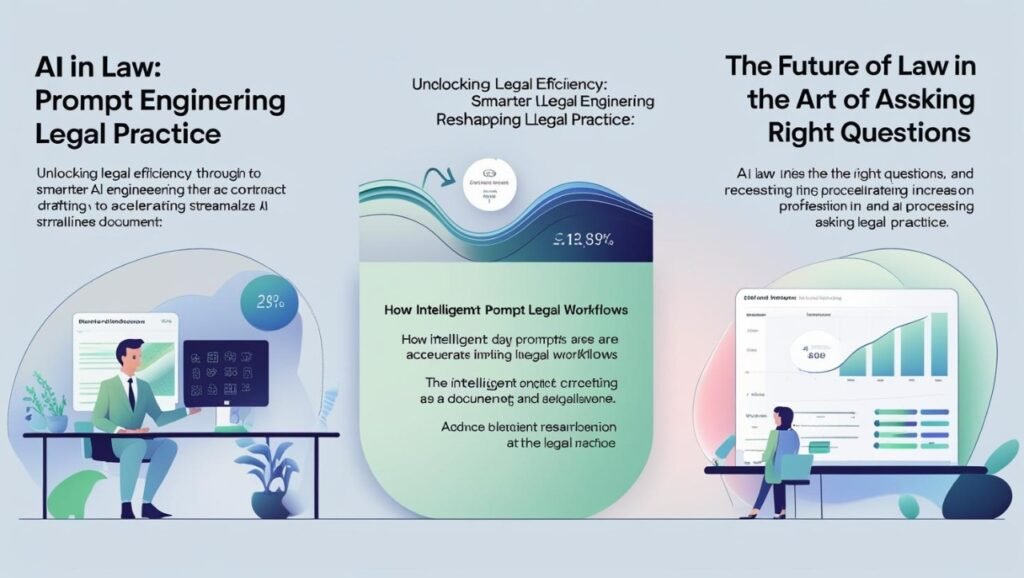
In the ever-evolving world of technology, Artificial Intelligence (AI) is making significant inroads into almost every industry, including the traditionally conservative legal field. One of the most transformative developments in this space is prompt engineering — a new skill set shaping how legal professionals interact with AI tools to perform complex legal tasks efficiently.
This blog aims to unpack how prompt engineering in AI is revolutionizing legal practice, streamlining workflows, enhancing accuracy, and ultimately changing how law is practiced in the 21st century.
What is Prompt Engineering?
Prompt engineering refers to the practice of crafting precise inputs (prompts) to elicit accurate, relevant, and useful responses from large language models (LLMs) like GPT-4. In simpler terms, it’s the art and science of “talking to AI” in a way that gets the desired output. The better the prompt, the better the response.
For example, a lawyer might use an AI tool to summarize a 50-page contract. The prompt could be as simple as:
Summarize the key liabilities in this contract in bullet points.
With refined prompting, legal professionals can now use AI to conduct legal research, generate first drafts of documents, and even assess case strengths and weaknesses.
Why is Prompt Engineering Important in the Legal Sector?
Law is a domain filled with nuanced language, specialized terms, and high stakes. Unlike casual conversation, legal outputs need to be precise, clear, and defensible.
Here’s why prompt engineering matters in law:
1. Reduces Errors: A well-crafted prompt reduces the chances of the AI misinterpreting the question or generating irrelevant responses.
2. Saves Time: Efficient prompts deliver useful outputs in seconds, reducing hours of manual work.
3. Customizes Outputs: Lawyers can tailor prompts for jurisdiction, legal topic, tone, or format — making AI far more effective.
4. Increases Confidence: With better results from AI, legal professionals gain trust in automated systems.
Real-World Applications of Prompt Engineering in Legal Practice
Here are some practical scenarios where prompt engineering is actively reshaping legal workflows:
1. Legal Research and Case Law Summarization
AI models can search and summarize legal cases when given a proper prompt like:
>List the top 3 Supreme Court rulings related to intellectual property infringement between 2015–2023. Summarize each in 200 words.
Legal researchers are now using prompt-based AI tools to cut research time by more than 70%.
2. Drafting Legal Documents
From NDAs and contracts to affidavits and memoranda, AI can draft or review legal documents using structured prompts like:
> Create a one-page NDA between a freelancer and a tech startup, governed by California law.
This not only speeds up the drafting process but also ensures consistency in legal language.
3. Due Diligence and Contract Review
Prompt engineering enables bulk analysis of clauses:
> Review this lease agreement and highlight any risks related to early termination.
Firms can use this for faster contract audits during mergers, acquisitions, or compliance checks.
4. Client Communication and Explanation
Clients often need legal advice in simple language. Prompts like:
> Explain the implications of a non-compete clause in plain English for a non-lawyer client.
> help lawyers provide accessible and understandable legal advice.
5. Litigation Strategy Development
AI can help generate argument maps:
> Generate possible arguments for and against a plaintiff in a civil case involving breach of fiduciary duty.
This aids litigation teams in brainstorming and preparing multiple approaches before court.
How Law Firms Are Adapting
Top law firms around the globe are embracing prompt engineering as a core part of their LegalTech strategy. Here’s how:
Internal AI Training: Many firms are now training their staff on how to effectively use prompt engineering to get the most out of AI tools.
AI-Powered Legal Assistants: Tools like Harvey AI, CaseText, and ChatGPT are being adopted across teams, especially in document-heavy practices.
Custom LLMs: Some large firms are developing their own custom-trained language models on proprietary case data, using prompt engineering to extract tailored insights.
Hybrid Roles: New job roles like “Legal Prompt Engineer” or “AI Legal Specialist” are emerging to bridge the gap between legal professionals and AI tools.
Benefits of Prompt Engineering in Law
Prompt engineering, when done correctly, offers a range of benefits:
✅ Speed and Efficiency
Routine legal tasks that would take hours — like summarizing deposition transcripts or scanning through lengthy contracts — can now be done in minutes.
✅ Accuracy with Customization
Fine-tuned prompts lead to more accurate, tailored results. Lawyers can even iterate prompts to refine answers further.
✅ Cost-Effectiveness
AI-driven legal work powered by prompt engineering significantly reduces billable hours for repetitive tasks, improving firm profitability.
✅ Enhanced Legal Accessibility
Smaller firms and solo practitioners can now access capabilities that were previously reserved for firms with huge research teams.
Challenges and Ethical Concerns
While the promise of AI and prompt engineering in law is exciting, it comes with some challenges:
⚠️ Data Privacy & Confidentiality
Using AI tools — especially cloud-based ones — requires strict attention to data privacy laws, client confidentiality, and jurisdictional data compliance.
⚠️ Legal Accuracy
AI tools can still hallucinate or generate plausible but incorrect legal statements. Without expert review, this can pose serious risks.
⚠️ Over-Reliance
There’s a danger of legal teams over-relying on AI without understanding its limitations. Human oversight remains essential.
⚠️ Prompt Quality
Bad prompts = bad output. Training legal professionals to write effective prompts is crucial for success.
Best Practices for Prompt Engineering in Legal Work
If you’re a legal professional looking to get started with AI, here are a few best practices:
Be Specific: The more context you provide, the better. Always include jurisdiction, law type, and formatting preferences.
Use Examples: If possible, provide examples of the output format you want.
Iterate: Don’t expect perfection on the first try. Improve the prompt based on the output.
Always Review Outputs: No AI tool is a substitute for qualified legal review.
Stay Updated: LLMs evolve fast. Keep up with best practices in prompting and model updates.
The Future of Prompt Engineering in Legal Tech
We’re just scratching the surface of what AI and prompt engineering can do in law. With the integration of multimodal AI (text + image + voice), soon lawyers might interact with AI using spoken language or visual data.
As AI becomes more embedded in legal processes, prompt engineering may become as essential to a lawyer’s toolkit as casebooks or LexisNexis. Law schools and bar associations are already beginning to discuss how to include AI literacy in legal education.
Conclusion
Prompt engineering is not just a tech trend — it’s a transformative force in modern legal practice. By enabling lawyers to harness the power of AI more precisely and effectively, it’s streamlining workflows, enhancing client service, and improving legal access for all.
As legal professionals continue to explore and adopt AI tools, mastering the art of prompt engineering will be a key differentiator. The firms that adapt now will set the standard for the future of the legal industry.
Are you ready to explore how AI and prompt engineering can upgrade your legal practice?
Whether you’re a solo lawyer, a mid-size firm, or a legal tech company — embracing this AI evolution today will prepare you for the legal challenges of tomorrow.

